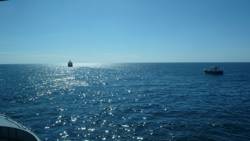Consilium Oil Spill Radar Tested
During three days of extensive testing, the advanced capability of Consilium’s oil spill radar to detect oil slicks has been successfully verified. The sea trials were part of an exercise in order to certify satisfactory safety and efficiency in oil spill response operations.
The operation was conducted by the Norwegian Clean Seas Association For Operating Companies (NOFO), from June 8 – 10, 2010. With the permission of the Norwegian Coast Guard, the Consilium Selesmar Selux ST 340 radar display and a 12kW 9ft antenna radar sensor were temporally installed on the Vessel KV Bergen. The Selux ST radar display was equipped with an add-on Special Edition software package, providing the advanced hardware video processing function to enable the detection and tracking of oil slicks.
Consilium reports that it is the first company in this market segment, able to provide an oil detection feature built into in an IMO/Solas ARPA navigational radar plant. The radar plant is using the same hardware already approved by the Federal Maritime and Hydrographic Agency in Germany and is compliant with the European Maritime Directive (MED).
The oil spill detection is also achieved by the performance of the Consilium radar sensor and by its capability to increase the speed of the antenna rotation to up to 44 rpm. The advanced video processing allows for operation under all kinds of visibility conditions. Trials were carried out both during day-light, as well as during night-time, with sea state 2 up to sea state 3-4.
Under all kinds of sea state conditions, oil slicks were detected and clearly recognized up to the maximum limit of the sea clutter map.













